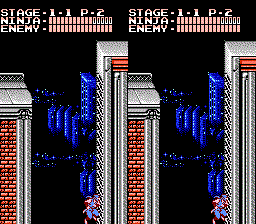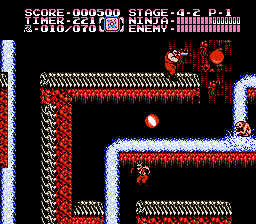Ninja Gaiden II: The Dark Sword of Chaos/Game Mechanics
From SDA Knowledge Base
Contents
Game Parameters and Controls
- Press Left and Right to run
- Press Up and Down while hanging from a wall to climb it
- Press Down while on the ground to crouch
- Press A to Jump
- Press B to Slash, damaging enemies, some projectiles, and breaking Item Orbs
- Hold Up and Press B to use Ninjutsu
- Must not be holding Left or Right
- Press Start to Pause and skip cutscenes
- Ryu has 16 HP, as do all bosses.
- All of Ryu's attacks will deal 1 damage.
- While in mid-air, you can't change the direction you are facing
- Moving backward in mid-air slows you down to about 1/3 of the speed of moving forward
- Slashing your sword has a 20 frame cooldown time. See Sword Slashing.
- Using Ninjutsu has a 20 frame cooldown time, and all projectiles must be off the screen before firing again.
- You can move Left or Right immediately after using Ninjutsu. This is Moonwalking.
- Ryu's HP is automatically refilled only after completing an entire act.
- Ryu begins every act with the Shuriken and 10 Ninpo.
- Ryu runs at 1.5 pixels per frame (at 60 fps).
- Ryu climbs at 1 pixel per frame.
- Ryu's collision box is horizontally smaller than in Ninja Gaiden, with respect to standing on surfaces.
Sword Slashing
- 20 frame cooldown.
- Slashing while standing on the ground forces you to stand still for the duration of the cooldown.
Jump Slashing
Like in Ninja Gaiden, it is useful to jump slash to kill ground-based enemies without stopping. However, in Ninja Gaiden II, the sword's hitbox is different such that it is often more difficult to successfully kill enemies with jump slashes. A and B must be hit in quicker succession than in Ninja Gaiden in order to kill most enemies. However, with a zero-time penalty from damage boosts in this game, it is often wiser to boost off of an enemy than kill it, or even to use ninjutsu to kill enemies at the expense of a few frames lost.
While slashing in mid-air, you can move left and right. But, if you slash in mid-air just before moving backwards, you move at full horizontal speed for the duration of the slash cooldown. This will not work if you have previously moved backwards in mid-air during the current jump. This is Backslashing.
- Example input: Facing Right: Tap A, tap B, hold Left
Slash Climbing
Unlike Ninja Gaiden I, you can climb up and down most walls in Ninja Gaiden II as if they were ladders. You can speed up the rate of your climb by jumping off of the wall, slashing immediately, and then moving back against the wall. If done quickly enough, you can gain 2-3 pixels in height each time this is executed. Since you climb at a rate of 1 pixel per frame, each successful slash-climb can save 2-3 frames. Done repeatedly throughout a run, several seconds can be saved. The technique can be difficult and tire your hands, though, so only do as much as you're capable of, as messing up can easily cause you to lose time.
Also note that this technique is especially fast in Stage 4-2 when climbing up waterfalls.
After reaching the top of a wall, you'll have to walljump at the top to finish the ascent. Since you'll be travelling at "backwards mid-air" velocity until you actually land on top, if you slash-climb during the walljump, you'll have full horizontal velocity already when you reach the top.
- Example input: Hold Right, tap A, tap B, release Right, hold left. If done while clung to a wall, this is Slash Climbing.
Canceling
This refers to bypassing the cooldown of slashing your sword or using ninjutsu. Normally, you have to wait 20 frames from slashing your sword before being able to slash it again. If you slash your sword just before landing from a jump, you don't slow down, and the slash cooldown is reset. This is a Landing Slash, which is one implementation of canceling. Like Slash Jumping, performing a Landing Slash is slightly more difficult in Ninja Gaiden II due to a difference in hitboxes from the first game. Also remember that like the first game, landing on the ground cancels the cooldown of your current attack, allowing you to attack again immediately, similiar to Castlevania: Symphony of the Night.
You can also jump after slashing on the ground to cancel it, minimizing time spent standing still and allowing another immediate slash in mid air. Combining these techniques together, you can slash 3 times in quick succession by doing a Landing Slash, a regular slash while on the ground, and a Jump Slash immediately afterwards. This can be abused to kill bosses in low% slightly faster, and in a Tool-Assisted Speedrun to kill some bosses nearly instantly.
Also note that if you jump immediately after using Ninjutsu, you can slash immediately (or use another ninjutsu, if the first shot has already left the screen) in mid-air.
Damage Boosting
A damage boost refers to purposely taking damage to save time, and is usually done in the following forms:
- Avoiding the damage would normally take too much time
- While not climbing, taking damage pushes Ryu upwards a few pixels, letting you reach some platforms quicker, or clip over walls.
- Taking damage gives you permanent invulnerability until you hit the ground, and then 1 additional second of invulnerability.
The mechanics of damage boosting is very similar to that in Ninja Gaiden I, with a few differences.
- While not climbing a ladder, taking damage pushes you in the direction that you got hit from.
You lose all control in this situation until you land on the ground. If you take damage while wallclimbing, there is no effect on your controls.
- You do not lose any horizontal speed when damage boosting. Whatever your previous horizontal speed was before the boost, that will be your speed during the boost.
This means that you can get boosted at full speed, even in Stage 2-2 when the wind is active. Thus, damage boosting in Ninja Gaiden II can rarely slow you down, and is encouraged almost everywhere that you cannot easily pass enemies, provided that you have the health to do so. Keep in mind that if you have recently moved backwards in mid-air, getting boosted will move you at the same slow speed, too.
- You gain a few pixels of vertical height when damage boosting, but not as much in comparison to Ninja Gaiden I.
While you can still reach higher platforms by damage boosting, it requires a bit more timing than in Ninja Gaiden I, since you usually have to hit an enemy at the pinnacle of your jump in order to get a successful increase in height.
Boost Grabbing
- If you take damage in mid-air, and Ryu's hitbox is overlapping a climbable wall, he will instantly begin climbing it and not be boosted. This is called Boost Grabbing. You must be holding Up for this to work.
In Ninja Gaiden I and II, there are no ceilings - you simply pass through solid wall by entering it from underneath. Also, some walls in the background can be climbed, but if you're on the ground, you'll simply walk in front of it (or inside of it). If you're inside a wall and want to climb up its side, you typically have to move outside of the wall and then move back towards it so that it'll detect collision against it and you can begin climbing. A Boost Grab is where you actually grab onto the wall earlier by simply taking damage while overlapping the side of the wall. You can be about 16 pixels from the edge of a wall and still cling to it after a Boost Grab. This is primarily useful in Stage 2-2, Stage 4-1, Stage 4-2, and Stage 7-1, saving significant time in most cases. If you're holding A and Left or Right during a Boost Grab, you instantly walljump, losing no horizontal speed.
Items, Ninjutsu, and Ninpo
Ninjutsu are the special abilities in the Ninja Gaiden games that can help Ryu make it through each stage. They typically cost some Ninpo, or Spiritual Strength, to use. Most ninjutsu are intended to deal damage to enemies, or help Ryu indirectly, such as the Shadow Clone. Ninjutsu and Ninpo can be found inside of Item Orbs, which are scattered throughout each stage.
Mechanics:
- Hold Up and Press B to use your current Ninjutsu.
- Must not be holding Left or Right.
- You can move Left or Right immediately after firing the Ninjutsu, resulting in a moonwalk.
- You begin the game with 10 Ninpo, 40 Max Ninpo, and the Shuriken.
- You begin each act with 10 Ninpo.
- If you game over, back to 10 Ninpo.
- You can collect an additional 10 Max Ninpo in each act after act 1 by collecting that act's Scroll.
- All Ninjutsu deals 1 damage per projectile against every boss. Shuriken does not damage bosses.
- You fire an additional projectile per Shadow Clone that is out.
Types of Ninjutsu
- Shuriken
- Windmill Shuriken
- Art of the Fire Wheel
- Invincible Fire Wheel
- Fireball
Other Items:
- Shadow Clone: An image that follows your movements, but attacks with you simultaneously.
- You can have up to 2 Shadow Clones out at once.
- Shadow Clones are retained across stages and acts, but are lost upon death.
- Simultaneous sword slashes will not deal additional damage to a boss, but simultaneous Ninjutsu will.
- Purple Ninpo: Restores 10 Ninpo.
- Orange Ninpo: Restore Ninpo to Max.
- Extra Life: Kills you.
- Orange Points: Gain 1000? points.
- Purple Points: Gain 300? points.
- Scroll: Adds 10 to your Max Ninpo.
- Can only collect 1 scroll per act.
- Acts 2-7 have Scrolls.
- Some acts have multiple scrolls, but after collecting one, the other Item Orbs that contained scrolls will instead drop Purple Ninpo.

